Want an electric conversion? Be prepared to pay big money

About five years ago, I wrote a piece for Hagerty defending vintage car ownership. In it, I said that, on the surface, owning multiple vintage cars may seem as irresponsible as former first lady of Philippines Imelda Marcos owning thousands of pairs of shoes and hundreds of fur coats, but I defended myself and like-minded car nuts by arguing that, from an environmental standpoint, lightly driven vintage cars have a very small carbon footprint. I joked that my 1974 Lotus Europa, having been dead for 40 years, still owes the world a few decades of carbon.
Not long after, I began seeing articles about electric conversions of classic vehicles. There were press releases from both Aston Martin and Jaguar saying—in response to some European cities proposing the closure of their downtown sections to internal combustion vehicles—that they were offering well-heeled clients factory electric conversion of their precious E Types and DBwhatevers. Reading further, this allowed for cost-sharing of the new electric platforms being developed for Jaguar’s I-Pace crossover and Aston Martin’s Rapide E, so the motives were perhaps not as bright green as they seemed.
Aston Martin’s release really caught both my eye and my ridicule, as it referred to its electric conversion as a “cassette,” with the implication that it could be easily slid in and out. “The cassette system offers the perfect solution, offering owners the reassurance of knowing their car is future-proofed and socially responsible, yet still an authentic Aston Martin, with the ability to reinstate its original powertrain if desired.
OK. Well. First, “future-proofed?” Really? Is it going to automatically encase itself in carbonite like Han Solo when sea levels rise or if an asteroid pulverizes the planet?

Second, knowing nothing about electric conversion but a little about engine swaps, the idea that every aspect of a gas-to-electric conversion can be encased in a “cassette” may be good public relations, but it is of dubious engineering merit.
You might infer from this that I’m anti-EV. Not true. I think that electric vehicles, when recharged with power generated by renewable energy sources (e.g. solar and wind) are part of a necessary response to climate change. But I am resolutely anti-hyperbole.
Since then, the electric conversion of classic vehicles, or at least the aggressive marketing of it, appears to have only increased. Nowadays, it seems that you can’t throw a bad condenser without hitting a laptop displaying an article about electrifying classic cars. Shops performing conversion work appear to be springing up in many American cities. Some are single-marque or single-theme, while others are equal opportunity converters.
Normally I wouldn’t pay any of this much mind, but an electric-converted 1974 BMW 2002 recently went up for auction on Bring a Trailer. As I’ve owned 40 of these little German sedans and still own three of them, I couldn’t help having some academic interest. Plus, there’s the odd bit of historical trivia that BMW actually built two electric 2002s that were used during the 1972 Munich Olympics. With 12 Varta lead acid batteries under the hood, the cars had a range of 37 miles at a constant 31 mph. Fortunately, EV technology has advanced over the last 50 years.

The work on the BaT 2002 was performed by a shop in Austin, Texas, that has received favorable press. The company’s website and videos show converted high-dollar classics like an E Type, a long-hood 911, and an Alfa GT Veloce. The company owner and his engineers exude passion for the work and respect for the art form that is a vintage car, and they reason that electric conversion a) makes a car environmentally palatable, b) increases performance, and c) solves the problem of the unreliability of a 50-year-old internal combustion vehicle. If I can nitpick about that last point, in one video, one of the engineers perhaps drank from Aston Martin’s fountain, as he strays from passion to hyperbolae and says that classic cars “are fickle finicky vehicles, but when it’s [sic] run by a massive battery and an electric motor, it’s basically as reliable as a microwave oven.”
I’ve written multiple articles about what I refer to as “The Big Seven” things likely to strand a vintage car. They are ignition, fuel delivery, cooling, charging, belts, clutch hydraulics, and ball joints. I fully agree that if you replace an internal combustion engine and its cooling and charging systems with a modern electric system, you eliminate the first five of these, and that’s nothing to sneeze at. But you still have a classic vehicle with its attendant electrical quirks (funny, right?), old brakes, steering, and suspension, and now you’re adding in the range and “who repairs it?” issues of a one-off electric conversion whose battery capacity is unlike to be that of a ground-up design.
But even assuming there’s a step increase in reliability, there’s a huge overriding issue with these conversions. And it’s not the whole “you’re destroying a classic” argument. As far as I’m concerned, it’s your car—go to town and paint flaming purple Smurfs on the hood if you like. In the case of the BaT vehicle, a BMW 2002 is a common model. There are a lot of them. It’s not like someone is electrifying James Bond’s DB5 (and, even if they were, if you believe Aston Martin, you could always just hit the eject button and swap back in the internal combustion “cassette”).
Nor is it the “you’re destroying the classic’s soul” argument. There’s a whole continuum of paths for ownership of a classic car, from keeping it bone stock, to light modifications for drivability and reliability, to hot-rodded, to wild engine swaps, to turning it into track-only vehicle or a race car. Electrification is somewhere on the right edge of this curve.
Personally, I think if you want a newer, quieter, more-powerful car, you should just buy a newer, quieter, more-powerful car and stop trying to turn your classic into something it isn’t. But to single out electric conversion and point at it—Invasion-Of-The-Bodysnatchers-style—as an affront against man, and God, is silly. That being said, I do have some “soul” concerns. I’ve experienced how even mild modifications such as a stiffer suspension or a five-speed retrofit can change the car in unintended ways, affecting the way it sounds, feels, and vibrates. The relationships we have with our beloved cars are intimate things, and changes in a car’s vibe can affect our connection with it. Even over and above electrification’s obvious “no more gas, oil, and exhaust fumes” and “no more WAAAAAAAAAA-waaaaaaa when you wind it out” issues, I do wonder about the degree to which removing some of a car’s grit and rasp and replacing it with an antiseptic Stepford-wife, golf-cart whine may stress or break the owner-vehicle bond.
But the issue, the thing I’d like to see addressed in the first sentence of every article about electric conversion, is the high cost. The website of the company that converted the BMW 2002 on BaT estimates conversion cost at $50K–$150K, depending on the vehicle’s make and model, the need for general non-electric-conversion restoration work, the desired level of performance, and other factors.
Holy electrons, Batman. You’d have to leak a lot of gas, oil, and antifreeze to approach that.
It made me wonder who spends this kind of money. One of the company’s videos talks about people who “want the ability to appreciate that art form, but they want… a sense that they’re doing it with less impact to our planet” and “want the seamlessness of not worrying, just driving.” That’s great PR, but to me that price tag instantly makes this kind of conversion the province of folks with summer homes in the Hamptons.
My ever-reasonable wife asked me, “How does that compare with the cost of a new EV? Couldn’t a buyer be someone who simply wants a cool vintage electric-converted car to use as a daily driver?” Left-brained me answered that vintage vehicles and daily drivers are usually two different things, and that only a died-in-the-wool car person would likely put up with the wind and road noise, primitive suspension, reliability, and safety issues of a classic car, electrified or not, to try to daily it for anything other than trivially short commutes.
Let’s look at the specifics of the electric-converted 1974 BMW 2002 on BaT. What the car had going for it was that it was converted by a known company, the photos of the converted portions appeared to show excellent work, the car was painted the highly desirable color of Colorado (pale orange), and although it began life as a big-bumpered square tail light 2002, it had received a small-bumper conversion.
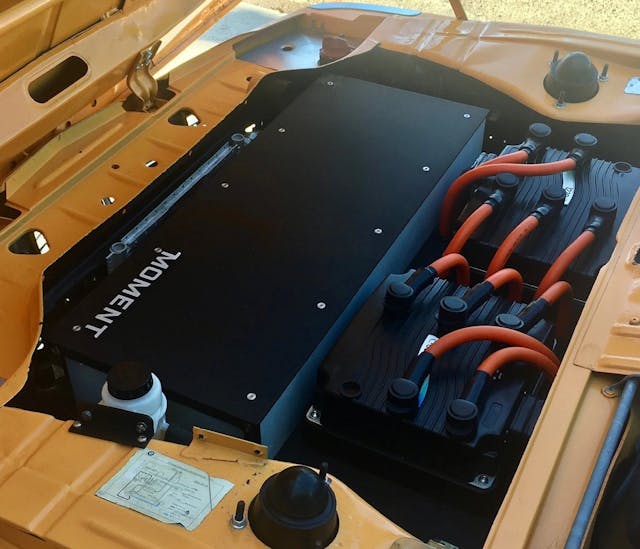
In addition, part of the converter’s design philosophy is to maintain the manual transmission and clutch, as that keeps the car fun to drive, and it doesn’t interfere with the look and feel of the gearshift lever. This car actually had a five-speed in it, which was pretty cool.
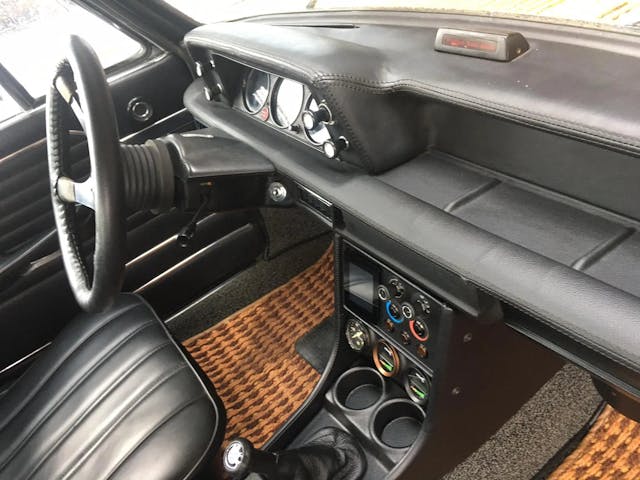
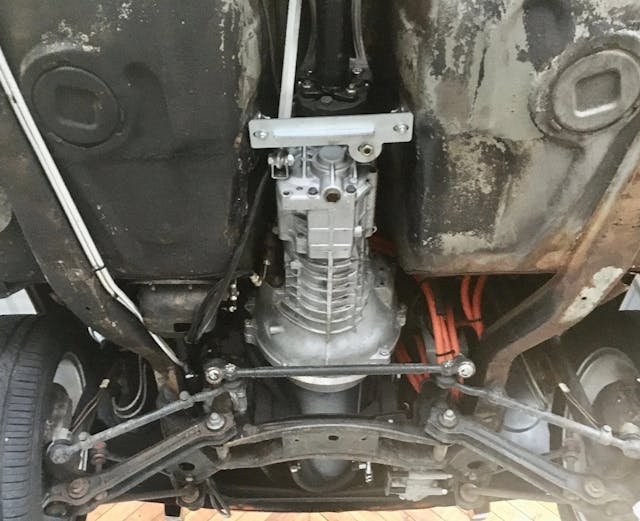
But there were some negatives. The rectangular holes for the original front bumpers’ hydraulic cylinders hadn’t been covered up; the car had been shaved (de-trimmed); it had air conditioning via a modern climate control box, whose vents were occupying the places in the dashboard where the original vent sliders were; and the dash had a stitched leather cover. OK, perhaps only the big bumper holes are a demerit, but while there’s nothing cringe-worthy with any of the other issues, there’s no denying that they collectively moved the car away from a bone-stock configuration. I’d think that from a value standpoint, a blue-chip electric-converted 2002 would be a flawless 1968–73 round-taillight car that looked absolutely stock until the hood was opened. This wasn’t that.
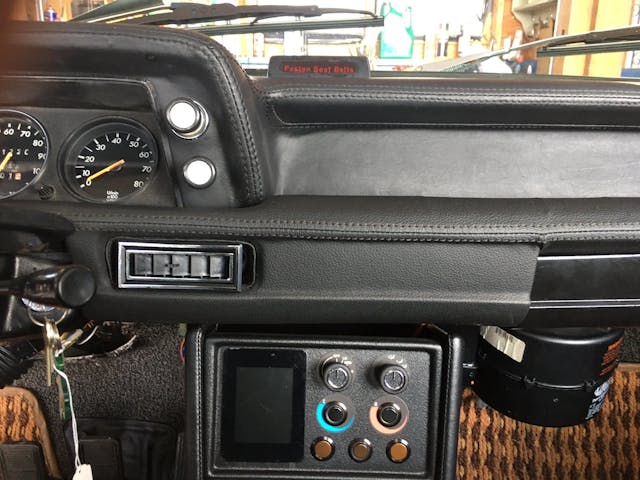

Plus, as pretty as the car’s exterior was, it had not had a rotisserie-style restoration, so the floor pans and subframes showed the small amounts of oxidation that every unrestored car has. Nothing wrong with that; every car I own looks likes this underneath. I imagined that the owner thought of the car as being in the Goldilocks zone for an electric conversion. That is, if it was too rare, too original, or too mint, you might not want to modify it, whereas if it was too beat-up or rusty, it wouldn’t be worth the expense and effort.
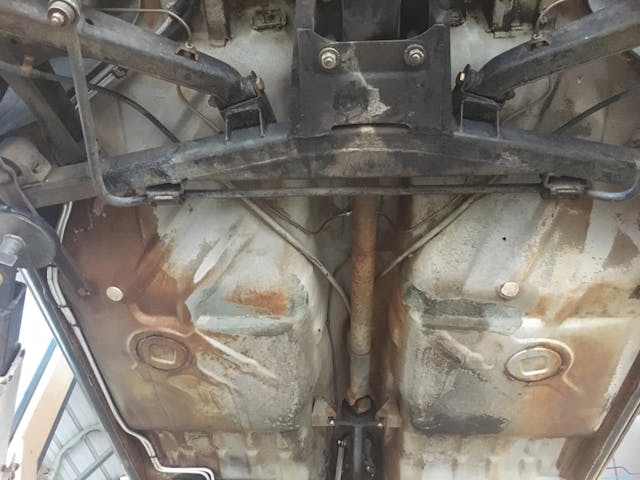
However, as I wrote when I tried to sell my 49,000-mile survivor 2002, what’s valued on BaT and causes bidding wars to head for the stratosphere are cars that present themselves in such a way that potential well-moneyed buyers think they’re bidding on a completed fully-executed whole that needs nothing. The contrast of a car’s freshly painted exterior with an original undercarriage conveys the image that the car is unfinished and holds the price on BaT down for any car. This was no exception.
The kicker was that although the car had a standard J1772 charging connector, and the conversion included a nifty adaptation of the stock gas gauge to display the reserve charge, the seller quoted the car’s range as only about a hundred miles. Gee, maybe things haven’t progressed as far as I would’ve thought since the 1972 Olympics.
Together, all these things added up to caveats that caused the bidding to top out at $42,500. Given the cost estimates listed on the conversion company’s website, I can’t imagine that the sale price wasn’t substantially less than the seller had in it.
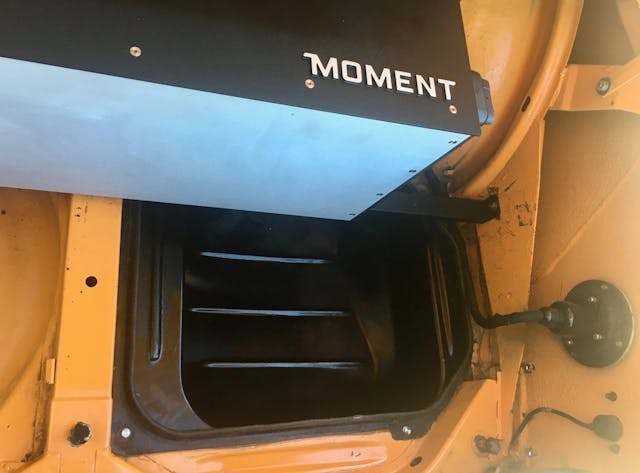
But still, $42,500 is a lot of money, at least it is to me, and that got me thinking.
As I say over and over, I am neither wealthy nor a collector. I own 13 vehicles (including a truck, little RV, and two daily drivers) because they’re either useful to me or they resonate with me in some way, but I struggle daily with both the financial and the storage repercussions. I see many cars locally on Craigslist and Facebook Marketplace that fall into what I think of as a “whim-able” price window. I used to regard this as four grand, in which all sorts of depreciated BMWs and running oddballs like Saab Sonnets, Fiat X1/9s, and ’63 Rambler 770s fall, but I’ve widened my view a bit to eight grand, as that also captures things like running but needy pre-1975 C3 Corvettes.
Still, in an environment of tightly-constrained money and space resources, the thought experiment I perform for any purchase—particularly one that’s outside my wheelhouse—is “What would I actually use the car for?” I know what I use the 1970s BMWs for. I road-trip the hell out of them. Yes, I also pleasure-drive them and use them to run errands—there’s nothing like taking a beloved classic to get milk on a Sunday morning to turn it into an event—but the road-trip part is in both my and the cars’ DNA. The Lotus Europa still hasn’t seen a big road trip, but I adore driving the featherweight little thing on twisty local roads. So, if the answer to the usage question is “I’d probably just drive it to cars and coffee a few times a year,” that’s a fail. I simply don’t have the space or the money to support owning something with that usage profile.
In truth, of course it’s less black and white than that. My 1999 BMW M Coupe (“the clown shoe”) is barely driven these days, and although my 49,000-mile 2002 did recently get a short road trip to Vermont, it’s more of an errand and a local events car. And some of my other ’70s BMWs haven’t seen a multi-day road trip in years.
But still, hypothetically, what would I actually use an electric 2002 (or any electrified classic whose range is only a hundred miles) for? That would seem to effectively rule out spirited day drives with my local 2002 pals. Yes, in theory, 30 minutes of a quick charger attached to the J1772 port should give an 80 percent charge, or another 80 miles, but that doesn’t feel like much. Me, I’d rather have the unconverted car with the range, the fumes, and the chunky rasp when I get on the throttle. And save the $42,500. Or the $50K–$150K, depending on how you want to look at it.
In my first book, there’s a chapter, titled “Restoration and why it makes no freaking sense,” in which I say that buying a car into which someone else has already sunk restoration money is almost always cheaper than spending the money yourself, but note how people pay to have cars restored anyway because it’s all about choice—what pops out at the end is the manifestation of all those choices, and so, naturally, you love it. I think that choosing to have a vintage vehicle electrified is a boutique subset of this larger restoration issue in that people who do it want to do it, probably because a) it fits their environmentally-friendly self-image, and b) they can afford it and the left-brain analytics probably don’t matter that much. I have no argument with that, but if you say that you’re doing it strictly for environmental reasons, and if your daily driver isn’t an EV, I think the justification is pretty thin. And if you say you’re doing it so you can still drive your beloved classic when gasoline is as controlled as ivory, okay, but you’re paying a very hefty premium to be on the bleeding edge. From this standpoint, the buyer of the electric 2002 on BaT made out very well.
So now I can tell you the surprising part: The BaT seller of the electric 2002 and the guy who paid to have the conversion work done was my old friend and BMW 2002 mentor from my days in Austin, Terry Sayther. Terry is 40-year member of the BMW Car Club of America, had a shop in Austin for decades, has forgotten more about 2002s than I’ll ever know, and has done a whole variety of engine swaps. In other words, the last thing he is is my hypothetical hedge-fund closet environmentalist EV-converted classic owner.
When I asked him why he did it, he said he wanted to experience an electric 2002 in the same way he wanted to experience a 2002 with a 240-horsepower S52 engine from an E36 M3 (which he also owns). He said that the electric 02 was very much a pleasure to drive, was a good city car (though more range would’ve been nice), was great to use on date nights with his wife, and, yes, did attract a lot of attention at cars and coffee events. So, you can ignore most everything I said.
Except the price tag.
If I’m still alive when gas really is akin to ivory, and the price of an electric conversion is comparable to that of an engine swap, I’ll likely change my tune (I’m above most things a practical man). Until then, you’ll recognize me because I’m the guy smiling as his car’s leaky fumy internal combustion engine is being wound out.
Really, I just want folks to be careful and realistic. The fact that an expensive boutique-converted electric BMW 2002 has only a hundred-mile range strikes me as a valuable illustration of where EV conversion technology is today and what is and isn’t reasonable to expect when you have to deal with the constraints of a vintage car. The time may come when electric conversion is the necessary and affordable way to keep driving your classic, but that time is certainly not today.
Oh, and that factory Jaguar electric E Type? Be careful what you wish for. This was the 2018 press photo of the dashboard in the prototype. If I ever owned an E Type, plunked down mortgage levels of money for electric conversion, and the interior came back looking like this, I’d want 10 minutes in a windowless room with the people who cashed my check.

***
Rob Siegel’s latest book, The Best of the Hack MechanicTM: 35 years of hacks, kluges, and assorted automotive mayhem, is available on Amazon. His other seven books are available here, or you can order personally inscribed copies through his website, www.robsiegel.com.


Rather amusing that Oslo bans ICE when Norway’s prosperity is based upon North Sea Oil. Hypocrisy never ceases to amaze me.
About 20% of Norway’s economy comes from oil. Maybe that’s how they recognized what a dirty industry it is and decided to compensate by striving toward clean energy.
Something I had not considered…let’s say far in the future (if I was still here and likely not) and had a beloved ’57 Nomad for which gasoline could no longer be had but I did have the 283 anchor dumped for and electric motor set up. The engine sounds that would no longer be prevalent would have been replaced by wind noises. Wind noises that are beyond those of today’s cars that are all much more aerodynamically designed. Would sound at highway cruising speeds make me crazy? I wonder.
Of course, if we were talking about a Countach…the soul of the car is the V12 engine. With a electric motor, it would be something of a beauty queen that was actually a mechanical doll, not the real thing. Let’s hope that 30 years from now that some sort of much cleaner fuel is readily available and these classics can be driven at least a limited number of miles per year. We can’t put all ’57 Nomads in museums and we can’t send them to the crusher either.
EV Trolls on this site
would not spend the money.to get it done..if this is what it comes down to..then my cars have to go, I am looking to join an outdoor gin club..and if the cars have to go,,then I build up the antique gun collection..and spend my time..picnicing,and target shooting..its destroying all the farms wooded areas,, and greenlands..to increse,,urban sprawl,,with oversize houses..tract sub divisions..and retial,,warehouse and commercal properties that is to blame for the damage to the enviorment..not cars
Good points. It’s your car. If you really want to spend (what I consider an absurd amount of) money to do this, then go for it. But are you really “future proofing”? What happens 10 or 20 years down the road when something in the electrified system need to be repaired or replaced? Will the shop that did it still be in business, or the vendors they bought the hardware & software still be in business? You may find that getting your classic running again will be more expensive and difficult that it would be than if it still had it’s old, classic ICE running gear.
And if you think you’re saving the planet by doing this, you’re deluding yourself.
There is an unnatural aversion to electric cars and that also applies to classics. At the current rate, almost all classic cars are destined to have a small block Chevy conversion sooner or later so you’ve already lost the originality. Electrifying classics as another accessible alternative is a good thing. The older vehicles get the more expensive and difficult it gets to keep them truly original. There is almost ALWAYS a compromise. To some folks, once resorted to a small block Chevy conversion, you might as well go all the way to electric and avoid all the ICE mess in the car, on your garage floor, not to mention all the commotion involved converting straight line explosions into rotational energy, running it through a high stall converter and a series of granny gears just to get it moving when you could have the instant torque of an EV. And you can just plug it into your wall instead of going to a gas station.
I can certainly agree with you on the cost, but there is one aspect you wholly missed out on with your EV conversion topic: performance. Now, clearly, if we are talking about a clear performance vehicle such as a 60’s muscle car or elite supercar, if the performance is already there and converting to electric merits no performance advantages, I would not condone the exchange. But if you find your 40’s or 50’s classic wheezing through a tired 6 cylinder, or a malaise era Mustang getting frumpy with a 4-banger, well a EV conversion granting you copious amounts of torque from zero RPM might just be the ticket for a new life on a tired old beast.
I have two old classic trucks: a 1951 Chevy 3100 5-window and a 1985 Nissan 720 standard cab. The ’51 has a lopey-idle 327 and 700r4 transmission, while the 720 has a rebuilt and modded Z24 engine and 5-speed manual. The Nissan is smaller, lighter, better handling, more fun and likely even faster than the old Chevy, even if it loses by horsepower and displacement. It also has a huge carburetor and gets V-8 type of gas mileage (in the low teens). So guess which one I plan to convert to electric? The Nissan of course. It’s not a “rare” collector vehicle and because of its size and weight will be much easier to convert and will be a more capable machine when finished. I’ve been in the planning stage for this conversion for over 10 years, and the things holding me back are mainly complexity and cost. But also the fact that my rebuilt truck runs great and only gets driven about 1000 miles a year.
Yet when the conversion finally gets started and then finished, the only thing I’ll care about is if I can smoke a C4 Corvette or Mustang Cobra at the 1/4-mile track, then pick up a load of gravel or bark on the way home afterward.
Rob…Your statement…..”You might infer from this that I’m anti-EV. Not true. I think that electric vehicles, when recharged with power generated by renewable energy sources (e.g. solar and wind) are part of a necessary response to climate change. But I am resolutely anti-hyperbole.”…….does not reflect reality. While wind and sunlight seem to be “free”–the operations for capturing them and resolving either wind or sunlight into electricity is costing Billions (if not Trillions) of dollars and billions of Barrels of none other than Fossil Fuels to manufacture. How is that productive when we say that our objective is to eliminate so much fossil fuel usage? Think on it. Behind the scenes, the truth is a really UN-green, sordid story! (some overly-enthusiastic promoters of Green Technology even are calling for NO Fossil Fuel usage. I can see them now–walking or crawling to work (if there will be work)–naked!